Episodic or persistent low back pain often indicates that inflammatory or degenerative-dystrophic disease is gradually forming in the body. Early diagnosis of the disease can increase the chances of full recovery. Pain in the lumbosacral area of the spinal space may indicate osteochondrosis, hernia, protrusion, infection, or problems with internal organs.
Why does the lower back hurt
If a person complains of painful manifestations in the lumbar spine, at first the doctor expresses suspicion about the patient's problems with the musculoskeletal system. And only after the disease is removed, a thorough examination is performed to assess the condition of the internal organs.

This is because there is general curing of the lumbar and intervertebral vertebral discs with nerve tissue trunks. For this reason, the appearance of pain, for example, in the digestive organs, can be given only to the lumbar region. Let’s find out in detail about some of the causes of back pain.
Excessive load
It is a relatively natural source of back pain. With physical hard work or active sports training, muscle tissue is exposed to excessive stress. It accumulates lactic acid, which irritates skeletal muscle tissue. As a result, in addition to pain, one notices the appearance of a fairly strong burning sensation. All discomfort disappears after a short rest, as lactic acid is removed from the muscles.
If back pain every time during exercise, if their intensity does not change for several hours, you should see a doctor. Excessive exercise, lifting heavy objects often gives rise to the appearance of microtraumes on the discs and vertebrae, the formation of diseases of a degenerative-dystrophic nature.
Osteochondrosis and intervertebral hernia
Lumbar osteochondrosis stages I, II and III are the leading causes of back pain. In the early stages, patients worry about minor discomfort, showing little damage to the intervertebral disc.
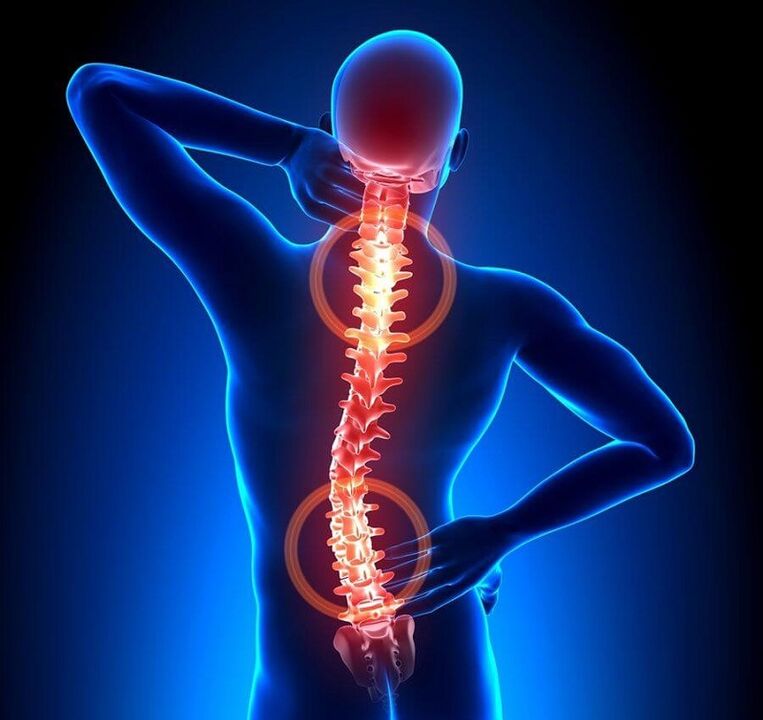
If the patient during this period seeks the help of a neurologist, complete cure of the disease, as well as partial recovery of the destroyed tissue, is possible. The sharp and severe pain that increases while bending or twisting the trunk indicates serious damage to the spinal structure.
Against the background of radiological osteochondrosis stage II or III, the formation of hernias or protrusions is often observed. As a result, stabbing pain appears, and even serious complications may arise - radicular syndrome, discogenic myelopathy.
Gynecological diseases
Discomfort in the lumbar spine often bothers women who have been diagnosed with adnexitis, an inflammation that simultaneously affects the ovaries and fallopian tubes (uterine complement). In addition to the pain syndrome, patients noted the occurrence of vaginal discharge, the emergence of problems with conception, and irregularities in the menstrual cycle.
Similar symptomatology is observed with inflammation of the uterine appendages, the formation of cysts in the ovaries, and the formation of polyps in the uterus.
Kidney disease
Because the kidneys are located right next to the lumbar region, when its function decreases, a person may feel pain in the lower back. The fact that the paired organs of these nuts are affected is indicated by a violation of urinary function, the appearance of purulent or bloody stools in the urine, and an increase in well -being in general.
Pain in the lumbar spine is often worrisome when there are diseases such as: cystitis (including hemorrhagic), glomerunonephritis, pyelonephritis, acute and chronic renal failure.
Bring a baby
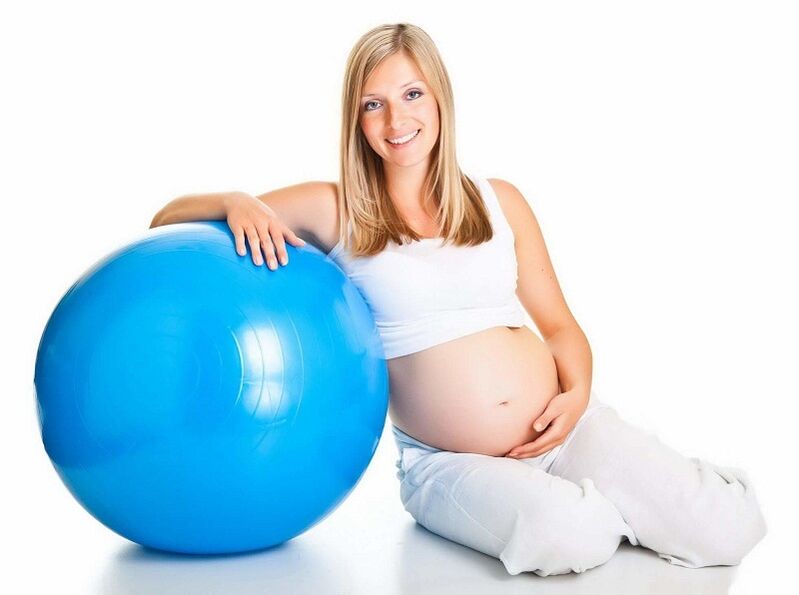
This is one of the natural factors that causes the manifestation of discomfort in the lumbar spine. When a woman becomes pregnant with a future baby, the uterus and fetus grow larger, due to which the nerve receptors located below are violated.
During the last trimester, the pregnant mother's body begins to produce a special hormone - relaxin. This leads to relaxation of ligaments, tendons, to facilitate the passage of the fetus through the birth canal. Because of this, the intensity of the pain can increase dramatically.
Endometriosis
This is a common gynecological disease, with the background of internal uterine tissue growing beyond its limits. Endometrioid tissue has an increased sensitivity to hormones synthesized by the body, for this reason, endometriosis manifests itself as monthly bleeding. As a result, inflammation develops, one of which is pain syndrome, which radiates to the lumbosacral region of the spine.
Mens
Painful manifestations of a strong attractive nature appear in half of women before menstruation or during bleeding. This pain is quite natural and disappears once your period is over. Discomfort can also be felt in the lower back.

The pathological etiology of lower back pain during menstruation is indicated by the presence of dyspeptic disorders, diarrhea or constipation, frequent headaches, and dizziness. In a similar situation, a woman can be diagnosed with algomenorrhea or menstrual dysfunction.
Breast size
Parts of the spine in women with large breasts are very numerous. If the mammary glands are not distributed properly, the risk of the formation of destructive-degenerative processes increases. Women with large breasts often bend over, which contributes to the deterioration of the spinal canal.
Uncomfortable shoes
The painful sensation in the lumbar spine that appears at the end of the working day is a common condition for women who walk in high -heeled shoes. This leads to violations of blood vessels, disturbances in blood circulation in the lower legs and pelvic organs. As a result, the nutrition of the intervertebral disc in the lumbar region worsens, as it is destroyed. The condition gets worse due to the increased pressure on the spine.
Menopause
During the menopausal period in the female body, there is a decrease in estrogen production which is involved in the regulation of the recovery process in the musculoskeletal system. The bone structure loses the ability to assimilate the trace elements needed for its recovery. It becomes brittle, which can cause frequent cracking. Painful manifestations in the lumbar spine during menopause may indicate bone resorption, the formation of osteoporosis.
Overweight
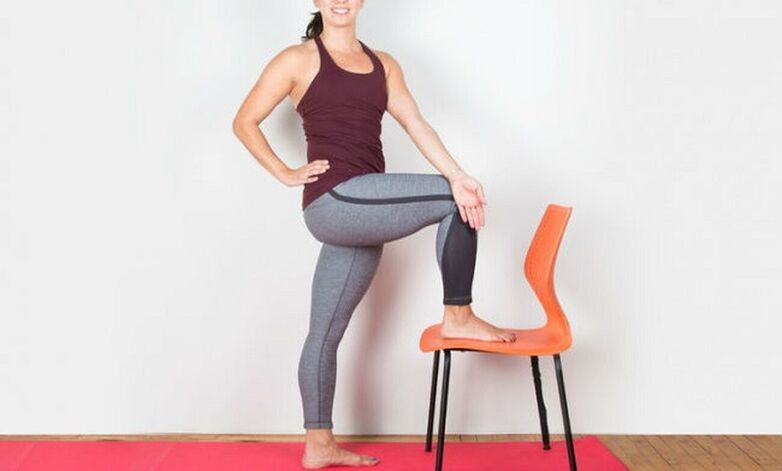
Being overweight is one of the causes of lumbosacral osteochondrosis. Excess weight increases the load on the intervertebral disc, leading to an increased risk of microtrauma with further destruction of vertebral tissue.
Someone who is overweight usually does not eat well. His diet is rich in high-calorie foods, and fresh vegetables and fruits that contain trace elements and vitamins are not eaten in sufficient amounts. With increased load in combination with a lack of useful substances, there is a tendency to form osteochondrosis of the lumbar region.
Oncology
Changes in the genetic structure of the cell cause a violation of the rules of its growth and reproduction. As a result, there is a proliferation of pathological tissues, the formation of tumors of a benign or malignant nature.
Pain in the lumbar spine can manifest itself against the background of tumor violation of sensitive nerve receptors, spine, soft tissues, and circulatory system. Calcium is absorbed in large amounts by neoplasms, as a deficiency of this substance develops in bone tissue, which causes bone thinning.
Hypothermia
Skeletal muscles in the lumbosacral region are often inflamed due to the influence of low temperatures. This causes the formation of myositis - a disease that manifests itself as a local pain syndrome in damaged muscles. Its intensity increases significantly during movement and palpation. Against the background of the inflammatory process, there is an increase in muscle tone, which makes the lower back less mobile.
Variety of pain
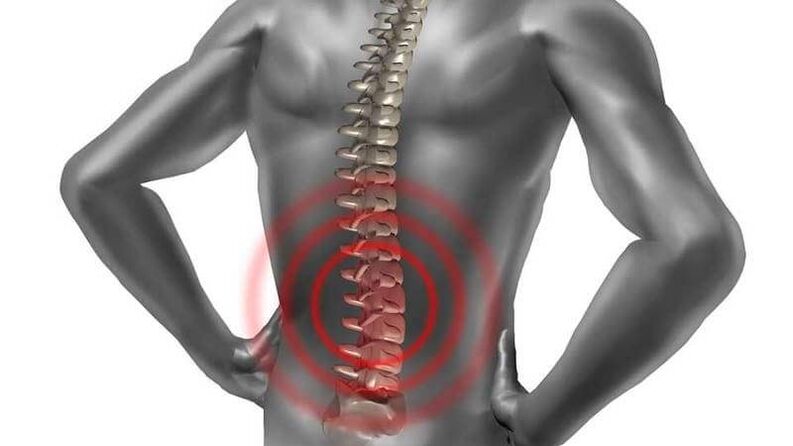
An early diagnosis can be made based on a detailed description of the disturbing symptomatology. With each disease, the pain manifests itself with different severity, frequency, conditions before it occurs.
Strong pain
This pain syndrome is typical for stage II and III lumbar osteochondrosis. At this stage, significant destruction occurs to the intervertebral discs, and their depreciating features disappear. They are unable to soften the load during movement, which makes the vertebral structure unstable.
This leads to soft tissue compression. Severe pain begins to bother even in a state of immobility, grows against the background of bends and bends, loud laughter, coughing and sneezing. In addition, there is a feeling of "goose bumps" and weakness in the muscles.
Sharp pain
The reason for the emergence of acute pain syndrome is the squeezing of receptors in the spinal canal by osteophytes or discs. This is typical for lumbago attacks, which are often manifested in rheumatic diseases, lumbosacral osteochondrosis, radiculopathies.
The painful sensation is so marked, stabbing, burning that the patient is unable to move. Often, a person is unable to straighten his or her back for fear of pain will appear.
A dull pain
Pain in the dull, aching and pressing lumbar spine is characteristic of diseases of the internal systems, including the genitourinary and reproductive organs. Such discomfort may indicate the development of osteochondrosis, spondyloarthrosis, spondyloarthritis.
The pain is not localized, but can radiate to the hips, buttocks and ankles. Often, excruciating pain is evidence of a destructive process in the spinal space or inflammation of an internal system.
Chronic pain

Persistent pain in the lower back indicates a change in the disease to chronic. It is sharp, strong during a relapse, radiating to nearby body areas. During the remission period, slight discomfort appears during hypothermia, physical exercise, exacerbation of other diseases, acute respiratory viral infections.
The pain syndrome increased with a background of bending, twisting, walking up stairs, and long walks.
Diagnostic measures
The disease is diagnosed based on the patient's complaints, his visual examination, anamnestic data, instrumental and laboratory diagnostic results. The most informative in identifying problems with the musculoskeletal system is X-ray examination. In the resulting picture, you can see the vertebrae altered, osteophytes formed (bone formation).
If the doctor suspects the development of a hernia, protrusion, diseases of the internal system, ultrasound, MRI and CT are prescribed. Thanks to this diagnostic method, it is possible to find out where the disease is localized, to assess the degree of development of inflammation.
Clinical study of blood and urine is mandatory. If there is a suspicion of systemic diseases (gout, rheumatoid arthritis), biochemical serological studies are performed.
Which doctor to contact
Often, back pain appears after an injury - vertebral subluxation, severe bruising, lesions of the spinal canal. In such a situation, you will need the help of a traumatologist.
You can also see a therapist. Such a doctor can diagnose diseases of the spinal canal, the internal system. After examining the diagnostic results, he or she will determine which narrow specialist consultation is needed (rheumatologist, neuropathologist or orthopedist) to prescribe further treatment.
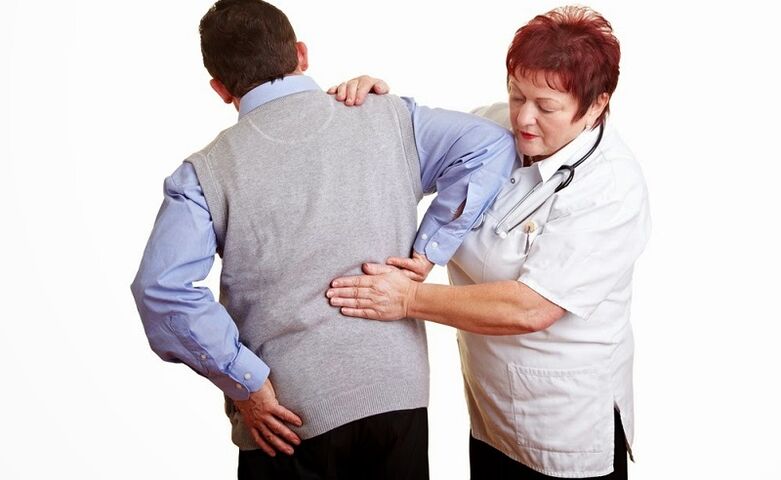
First aid
If there is severe acute pain, the victim should be placed on a hard surface in a situation where the discomfort becomes less obvious. You can lie down with your knees slightly bent and place a rolled up blanket under it. To relieve pain quickly, you can take non-steroidal anti-inflammatory drugs.
Therapeutic action
Analgesics can help relieve back pain. The effects will not last long if you do not treat the underlying disease properly. Several pathologies of the internal system are well treated, including oncology. But complete recovery of destroyed intervertebral discs and deformed vertebrae against the background of osteochondrosis is impossible. The goal of therapy is to achieve stable remission, in which pain in the lumbar spine does not interfere.
Drug therapy
First of all, for back pain, the intake of nonsteroidal anti-inflammatory drugs (NSAIDs) in the form of tablets or capsules is prescribed.
If there is an oncological disease, they need the help of narcotic analgesics. If pain occurs due to skeletal muscle spasm, muscle relaxation is indicated.
In the treatment of diseases of the internal system, analgesics are also prescribed.
Treatment with ointments and gels
Ointments and gels are used to relieve mild to moderate discomfort in the lumbar region. Drugs for external use are also included in the therapeutic regimen to reduce the dose of injections and tablet drugs, to reduce the pharmacological burden on the body.
For back pain, the use of external agents from the following groups can be prescribed:
- NSAIDs - have anti -inflammatory, analgesic and decongestant effects.
- Warming gels and ointments - have analgesic, local irritant and irritating effect.
- Chondroprotectors against the background of osteochondrosis - have analgesic and anti -inflammatory effects, stimulate disc recovery.
Injections
Choosing painkillers, the doctor based on the type of disease, its course, the severity of the pain syndrome. To relieve acute pain, they often use the aid of drug blockade with the use of glucocorticosteroids and anesthetics. The use of hormonal agents is quite dangerous for the body, so the procedure can be performed a maximum of 1 time in 1-3 months.
To relieve severe pain, NSAIDs are prescribed in the form of injections into the muscles.
Physiotherapy
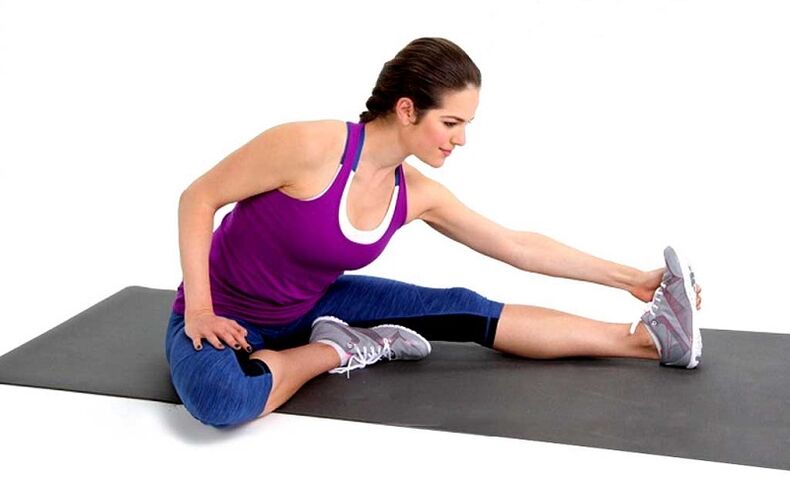
If the disease has been diagnosed, or to prevent its development, specialists advise patients to perform therapeutic gymnastic exercises every day. This will help:
- increase blood circulation in the lumbar region;
- strengthens the skeletal muscles of the back;
- reduce pain intensity.
The gymnastics complex is developed by the attending physician based on the type of disease, the complications present, and the physical condition of the patient.
Massage treatment
To increase the supply of blood and nutrients to the tissues, to normalize the tone of skeletal and smooth muscles, to strengthen muscles, it is recommended to do a massage:
- classic;
- point;
- segment;
- in cans.
Massage is prescribed for therapeutic purposes and to prevent the worsening development of chronic pathology.
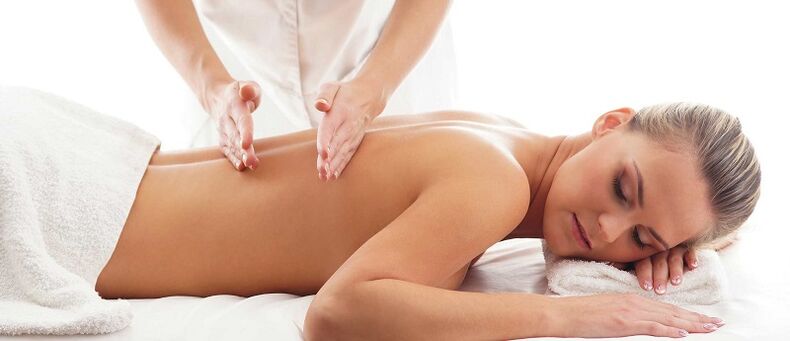
Hot and cold treatment
The effect on the lumbar spine with heat helps to relieve pain, but only after the acute inflammatory process is stopped. For this purpose, heating pads, warming ointments or gels, baths are appropriate.
Under the influence of cryotherapy (cold treatment), the adaptive system is activated. At the heart of this physiotherapeutic procedure, the body’s response is not hypothermia to the outer layer of the skin.
Precautions
It is possible to prevent the occurrence of pain in the lumbar spine by excluding the factors that can provoke the appearance of the problem. You should stop walking with high -heeled shoes, to reduce the consumption of high -calorie foods. Exercise, swimming, and regular yoga are good prophylaxis.













































